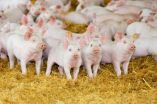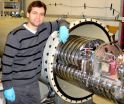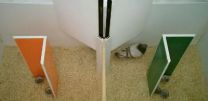(Press-News.org) University of Adelaide research has shown that piglets can be weaned later with no negative effects on sow birthing frequency.
The outcome of the study at the University's Roseworthy campus, published in the journal Animal Reproduction Science, is an important finding for pig producers. It allows improvements in piglet health and welfare without loss of production.
"Sows don't usually start their oestrous cycles again during lactation, only coming on heat after their piglets have been weaned," says Ms Alice Weaver, PhD candidate with the School of Animal and Veterinary Sciences.
"In commercial pig production, this has meant the reduction of piglet weaning ages in order to maximise the number of litters a sow can produce each year.
"Unfortunately piglets weaned early often don't thrive, with reduced growth and diarrhoea common."
Ms Weaver's study investigated whether oestrus could be stimulated while sows were still feeding their piglets so the sows could be mated before their piglets were weaned. Her project was under the supervision of Dr Will van Wettere, who leads a number of research projects in improving pig fertility and life expectancy of piglets.
Different treatment groups were set up among the Large White/ Landrace cross sows, with half of the sows weaned early at day seven after birth and half at day 26. Half of each group had daily contact with boars from day seven.
"The research showed that providing sows daily contact with a mature male pig seven days after giving birth is sufficient to stimulate oestrus regardless of whether they were still suckling a litter or not," says Ms Weaver.
"We've shown that piglet weaning age should be able to be increased with sows still producing the average 2.4 litters a year.
"This is very important to the pig industry and should lead to improvements in post-weaning growth and the welfare and survival of piglets.
"Most piglets in Australia are weaned at an average of 24 days. If we can push that out to at least 30 days, the extra time will have significant benefit for the piglets."
Continuing research is looking at whether there are any negative impacts on the following litter, which would be conceived and gestating while the sow was still suckling the previous litter. The research is supported by the Pork CRC which is based at the Roseworthy campus.
INFORMATION:
Media Contact:
Alice Weaver
PhD student
School of Animal and Veterinary Sciences
The University of Adelaide
Phone: +61 8 8313 1243
Mobile: +61 (0)407 974 638
alice.weaver@adelaide.edu.au
Dr Will van Wettere
Lecturer
School of Animal and Veterinary Sciences
The University of Adelaide
Phone: +61 8 8313 7911
Mobile: +61 (0)423 155 750
william.vanwettere@adelaide.edu.au
Robyn Mills
Media and Communications Officer
The University of Adelaide
Phone: +61 8 8313 6341
Mobile: +61 410 689 084
robyn.mills@adelaide.edu.au
Piglet weaning age no bar to litter frequency
2014-08-27
ELSE PRESS RELEASES FROM THIS DATE:
Measurement at Big Bang conditions confirms lithium problem
2014-08-27
The field of astrophysics has a stubborn problem and it's called lithium. The quantities of lithium predicted to have resulted from the Big Bang are not actually present in stars. But the calculations are correct – a fact which has now been confirmed for the first time in experiments conducted at the underground laboratory in the Gran Sasso mountain in Italy. As part of an international team, researchers from the Helmholtz-Zentrum Dresden-Rossendorf (HZDR) studied how much lithium forms under Big Bang conditions. The results were published in "Physical Review Letters".
Lithium, ...
Gamblers are greedy bird-brains, University of Warwick research finds
2014-08-27
Gamblers are greedy bird-brains, University of Warwick research finds
Gamblers show the same tendencies as pigeons when they make risky decisions, new research has shown.
Researchers, led by Dr Elliot Ludvig of the University of Warwick's Department of Psychology, conducted tests that found that both human gamblers and pigeons were 35% more likely to gamble for high-value than low-value rewards.
Published in Biology Letters, the researchers argue that the test results show the important role that memories of previous biggest wins and losses play when we make risky ...
The thunder god vine, assisted by nanotechnology, could shake up future cancer treatment
2014-08-27
Hepatocellular carcinoma (HCC) is the second leading cause of cancer-associated death worldwide. These regrettably poor prognoses are due to the difficulty in treating this cancer using conventional chemotherapeutic drugs such as doxorubicin, epirubicin, cisplatin, 5-fluorouracil, etoposide or combinations therein. This may be attributed to that the conventional medicines are not able to reach in a sufficient concentration in the liver tumor cells at levels that are not harmful to the rest of the body. Considering the large percentage of patients that are deemed ineligible ...
DTU researchers film protein quake for the first time
2014-08-27
One of nature's mysteries is how plants survive impact by the huge amounts of energy contained in the sun's rays, while using this energy for photosynthesis. The hypothesis is that the light-absorbing proteins in the plant's blades quickly dissipate the energy throughout the entire protein molecule through so-called protein quakes. Researchers at DTU Physics have now managed to successfully 'film' this process.
Both plants, algae and bacteria contain light-absorbing proteins which play a role in photosynthesis and thus how the organisms produce energy. However, it has ...
A prescription for better stroke care
2014-08-27
TORONTO, Aug. 27, 2014 – Stroke patients are 70 per cent more likely to continue taking their stroke prevention medications one year later if they have a prescription in hand when discharged – according to researchers at St. Michael's Hospital and the Institute for Clinical Evaluative Sciences (ICES).
Using data from 11 stroke centres, researchers determined how many Ontarians were taking their medications one week, one year and two years after having a stroke. The results reveal the importance of simple interventions, such as giving a prescription to a patient before ...
The roots of human altruism
2014-08-27
VIDEO:
Sakis play the group service game.
Click here for more information.
Scientists have long been searching for the factor that determines why humans often behave so selflessly. It was known that humans share this tendency with species of small Latin American primates of the family Callitrichidae (tamarins and marmosets), leading some to suggest that cooperative care for the young, which is ubiquitous in this family, was responsible for spontaneous helping behavior. But it ...
Fighting prostate cancer with a tomato-rich diet
2014-08-27
Men who eat over 10 portions a week of tomatoes have an 18 per cent lower risk of developing prostate cancer, new research suggests.
With 35,000 new cases every year in the UK, and around 10,000 deaths, prostate cancer is the second most common cancer in men worldwide.
Rates are higher in developed countries, which some experts believe is linked to a Westernised diet and lifestyle.
To assess if following dietary and lifestyle recommendations reduces risk of prostate cancer, researchers at the Universities of Bristol, Cambridge and Oxford looked at the diets and lifestyle ...
Leading scientists call for a stop to non-essential use of fluorochemicals
2014-08-27
Fluorochemicals are synthetically produced chemicals, which repel water and oil and are persistent towards aggressive physical and chemical conditions in industrial processing. These characteristics have made the fluorochemicals useful in numerous processes and products, such as coatings for food paper and board.
The problem with fluorochemicals is that they are difficult to break down and accumulate in both humans and the environment. Some fluorochemicals have known correlations with harmful health effects, such as cancer, increased cholesterol and a weaker immune system ...
Penn paleontologists describe a possible dinosaur nest and young 'babysitter'
2014-08-27
Dinosaurs are often depicted as giant, frightening beasts. But every creature is a baby once.
A new examination of a rock slab containing fossils of 24 very young dinosaurs and one older individual is suggestive of a group of hatchlings overseen by a caretaker, according to a new study by University of Pennsylvania researchers.
Penn's Brandon P. Hedrick and Peter Dodson led the work, collaborating with researchers from China's Dalian Museum of Natural History, where the specimen is held. Hedrick is a doctoral student in the School of Arts & Sciences' Department of Earth ...
Potential therapy for incurable Charcot-Marie-Tooth disease
2014-08-27
This news release is available in German.
Charcot-Marie-Tooth disease type 1A is the most common inherited disease affecting the peripheral nervous system. Researchers from the Department of Neurogenetics at the Max Planck Institute of Experimental Medicine and University Medical Centre Göttingen have discovered that the maturity of Schwann cells is impaired in rats with the disease. These cells enwrap the nerve fibres with an insulating layer known as myelin, which facilitates the rapid transfer of electrical impulses. If Schwann cells cannot mature correctly, ...







